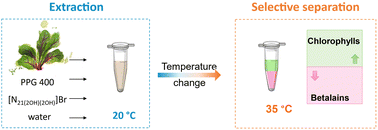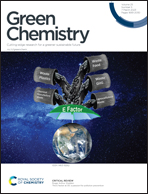Valorisation of red beet waste: one-step extraction and separation of betalains and chlorophylls using thermoreversible aqueous biphasic systems†
Abstract
Globally, up to 50% of root crops, fruits and vegetables produced is wasted. Beetroot stems and leaves fit into this scenario, with only a small fraction being used in cattle food. One way of approaching this problem is through their valorisation, by extracting and recovering valuable compounds present in this type of waste that could be used in other applications, while contributing towards a circular economy. In this work, a new integrated process using thermoreversible aqueous biphasic systems (ABS) composed of quaternary ammonium-based ionic liquids (ILs) and polypropyleneglycol 400 g mol−1 (PPG) is shown to allow the one-step extraction and separation of two pigment classes—betalains and chlorophylls—from red beet stems and leaves. The pigment extraction was carried out with a monophasic aqueous solution of the IL and PPG, whose phase separation was then achieved by a temperature switch, resulting in the simultaneous separation of chlorophylls and betalains into opposite phases. A central composite design was used to optimise the extraction parameters (time, temperature, and solid : liquid (S/L) ratio) of both pigment extraction yields, reaching at 20 °C, 70 min and a S/L ratio of 0.12 a maximum extraction yield of 6.67 wt% for betalains and 1.82 wt% for chlorophylls (per weight of biomass). Moreover, it is shown that aqueous solutions of ILs better stabilise betalains than the gold standard solvent used for the extraction method. Among the studied systems, the ABS comprising the IL N-ethyl-N-methyl-N,N-bis(2-hydroxyethyl) bromide ([N21(2OH)(2OH)]Br) presented the best separation performance, with an extraction efficiency of 92% and 95% for chlorophylls and betalains, respectively, for opposite phases. The pigments were removed from the respective phases using affinity resins, with high recoveries: 96% for betalains and 98% for chlorophylls, further allowing the IL reuse. Finally, the cyto- and ecotoxicities of the quaternary ammonium-based ILs were determined. The obtained results disclosed low to negligible toxicity in the thousands of mg L−1 range, with [N21(2OH)(2OH)]Br being harmless from an ecotoxicological point of view. Overall, it is shown here that the developed process is an innovative approach for the one-step extraction and selective separation of pigments contributing to the valorisation of waste biomass.

- This article is part of the themed collections: Circularity showcase and International Symposium on Green Chemistry 2022


 Please wait while we load your content...
Please wait while we load your content...